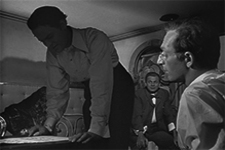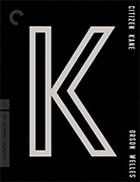Citizen Kane (4K UHD)
|  Really, what is there left to say about Orson Welles’s masterpiece Citizen Kane? What can one say that hasn’t already been said about the film most commonly referred to as “the greatest film ever made?” The film that topped Sight & Sound’s illustrious critical poll every decade from 1962 to 2012, the American Film Institute’s “100 Best Movies” list, the BBC’s “100 Greatest American Films” poll, and the Village Voice’s “Best Film of the Century” poll? The film whose presence in popular culture is so deeply ingrained that few even recognize how much of what we see today is indebted to it? The film that has inspired numerous homages and parodies in The Simpsons and one of the funniest and cruelest Peanuts comic strips (Lucy, upon seeing that poor Linus is watching the film, doesn’t hesitate to reveal the ending)? The film whose title has long since become a commonly used descriptor for the greatest anything in any category, even by people who haven’t even seen it? The film that is, literally, the Citizen Kane of films? There is so much to say about Welles’s grand cinematic debut—the one moment in his entire career that he had both absolute artistic freedom and all the resources he needed to achieve his vision—and yet I can’t help but think that anything I have say about it has already been said by someone else, and probably more eloquently. It is rare that, when writing about a film, I feel utterly dwarfed by it, but such is the case with Citizen Kane, not only because of the immense reputation it has been building for decades as the “greatest film ever made,” but because of its actual achievements. Citizen Kane was so far ahead of its time that audiences in 1941 weren’t entirely sure what to make of it. Critics recognized that there was greatness in it—in the New York Times, Bosley Crowther enthused that it was “far and away the most surprising and cinematically exciting motion picture to be seen here in many a moon” and that “it comes close to being the most sensational film ever made in Hollywood”—and it was afforded a number of awards at the time, including Best Film of the Year from the National Board of Review and the New York Film Critics Circle, as well as nine Oscar nominations, only one of which the film won (Best Screenplay for Herman J. Mankiewicz and Welles). Rather than try to write some kind of summative critical statement about Citizen Kane, I would rather like to approach it in terms of those elements that I most appreciate—understanding, of course, that this will necessarily entail leaving out so very, very much (but, there have already been numerous books written on Welles and his films by luminaries such as James Naremore and Joseph McBride, so completists can look to those). I would have to start with the film’s chutzpah, which is the well from which its greatness springs. Welles was in his early 20s when he began work on Kane, having already conquered Broadway with his daring adaptations of Macbeth set in Haiti and Julius Caesar set in fascist Italy and the airwaves with his extensive vocal work on serials like The Shadow and the productions of his own Mercury Theatre On Air, which he cofounded with John Houseman. When Welles was signed to a two-picture deal with upstart studio RKO that gave him complete artistic control, he had already achieved without shooting a single roll of celluloid on set what many other seasoned directors with decades of experience had never been afforded. He was a kid in a candy story, an enfant terrible with a visionary understanding of the artistic tools at his disposal, and he attacked his first Hollywood production with the kind of gusto and abandon that results in either a masterpiece or a disaster. The extent of his daring can be gauged in the subject matter he chose for his first film, a thinly veiled fictionalization of media baron William Randolph Hearst, who at the time was one of the richest and most powerful men in the world. Heart’s on-screen corollary, Charles Foster Kane (played by Welles himself), is the heir to a gold fortune who stakes his claim in the world by running a small New York newspaper and turning it into a yellow journalism phenomenon, much to the consternation of his guardian, the Scrooge-like banker Walter Parks Thatcher (George Coulouris). Citizen Kane is first and foremost a profound psychological study of an immensely complicated man, who begins life as a daring upstart and ends it in ruin. It’s a portrait of hubris, stubbornness, and ideals gone sour, and Hearst detested it so much that he tried to have it suppressed. Perhaps he recognized too much of himself in Kane’s rise and fall, although persistent rumors suggest that what he really loathed was the depiction of Kane’s second wife, the shrill, talentless singer Susan Alexander (Dorothy Comingore), as a corollary of his long-time mistress, the actress Marion Davies. That Welles would dare to incite the wrath of someone so powerful by using him as a portrait of all that is wrong in the world is testament to his brash confidence and willingness to put everything on the line to make something meaningful. Being a first-time film director, Welles was smart enough to know that he didn’t know anything, which is why he studied intensely (especially the films of John Ford) and surrounded himself with first-rate cinematic collaborators, including cinematographer Gregg Toland, who had worked extensively with Ford and won an Oscar the previous year for Wuthering Heights (1939); prolific art director Van Nest Polglase (Gunga Din, Top Hat) and set decorator Darrell Silvera (The Hunchback of Notre Dame); and special effects supervisor Vernon L. Walker (the film also gave a start to several soon-to-be-prominent figures, including editor Robert Wise, who would go on to become a multi-Oscar-winning director, and composer Bernard Herrmann, who would become Hitchcock’s favorite collaborator). Working together, they turned Citizen Kane into a visual marvel of expressionistic deep-focus cinematography, elaborate production design, and varied editing rhythms. The cinematography alone would make the film a masterpiece, as Toland turns every shadow and shaft of light into something deeply, emotionally, and symbolically compelling, while Welles finds all manner of expressiveness in mirrors, stacks of newspapers, and the placement of his characters within the frame (the manner in which he conveys relative power via his staging is remarkable). The film was rightly celebrated by French film critic André Bazin for its long takes and deep space staging, which were surely inspired by Welles’s time on the theatrical stage (amazing that the film itself never feels the least bit stagy), but there are also brash moments of editing genius, from the famous “breakfast table montage” in which Welles depicts the dissolution of Kane’s first marriage, to cuts that move us without warning decades into the future (“Merry Christmas” sneers 8-year-old Kane to Mr. Thatcher in one shot, followed by a direct cut to a much older Mr. Thatcher nearly two decades later dictating “... and a Happy New Year!” in a letter to the now-adult Kane). Which brings us to the film’s narrative style. Long before it was a trendy sleight of cinematic hand, Welles decided to tell the story in nonchronological order, giving us Kane’s life not from birth to death, but in abstracted snippets pieced together by a reporter as he interviews those who knew Kane before he died—some of whom loved him, some of whom loathed him, and some of whom felt pangs of both. The film actually opens with Kane’s death in his palatial mansion Xanadu (an obvious stand-in for Heart’s obscenely large Sam Simeon estate), which has been reduced to a gothic horrorshow of expressionist decay and shadows (the film’s opening moments could easily be the beginning of a Universal horror film). His final word “Rosebud” becomes the driving force in the film, as the reporter seeks to determine what or who this Rosebud is as a means of figuring out who Kane is. By telling his life story out of order, the film reflects how we understand our world and the people in it: Not as neat, clear, linear stories with all the right pieces of information revealed at just the right time, but rather as a messy, disorganized jumble of memories and feelings, some of which conflict with the others. As the reporter interviews Kane’s various associates, friends, and enemies, including the aforementioned Susan Alexander and Walter Thatcher (the latter through his unpublished memoirs, which are housed in a mausoleum-like archive as cold and foreboding as he was), Kane’s best friend Jedediah Leland (Joseph Cotton), and his long-time business manager Mr. Bernstein (Everett Sloane), he finds shards of Kane’s life that together create less a coherent portrait than a partially completed mosaic that, depending on which angle it is viewed from, shows us something different. Kane is magnanimous and proud, but also sad and desperate. Welles makes him both a leading light and a fool, a man of many flaws and many aspirations whose lonely death foretells his ultimate unknowability. Not to spoil anything for those who haven’t seen it, but Citizen Kane’s greatest daring is that it banks its entire narrative on trying to understand a singular man and then refuses to follow through, not out of perverse nonconformity, but out of the recognition that no one can be fully understood, least of all through something so blunt as one’s last words. The film’s haunting final images in which we finally learn the mystery of Rosebud (something that is withheld from everyone on screen), it simultaneously tells us everything and nothing.
Copyright © 2021 James Kendrick Thoughts? E-mail James Kendrick All images copyright © The Criterion Collection / Warner Bros. | |||||||||||||||||||||||||||||
Overall Rating: 


 (4)
(4)


